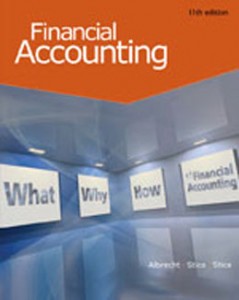Test Bank for Financial Accounting, 11th Edition: Albrecht
$35.00 Original price was: $35.00.$26.50Current price is: $26.50.
Test Bank for Financial Accounting, 11th Edition: Albrecht
Test Bank for Financial Accounting, 11th Edition: Albrecht

Product details:
Table contents:
PART ONE Financial Reporting and the Accounting Cycle
1(212)
Accounting Information: Users and Uses
2(22)
What’s the Purpose of Accounting?
4(3)
The Relationship of Accounting to Business
6(1)
Who Uses Accounting Information?
7(4)
Lenders
9(1)
Investors
9(1)
Management
10(1)
Other Users of Financial Information
10(1)
Within What Kind of Environment Does Accounting Operate?
11(5)
The Significance and Development of Accounting Standards
12(1)
The Financial Accounting Standards Board
12(1)
Other Organizations
12(1)
International Business
13(1)
Ethics in Accounting
14(1)
Technology
15(1)
So, Why Should I Study Accounting?
16(2)
End-of-Chapter Materials
18(6)
Financial Statements: An Overview
24(46)
The Financial Statements
25(1)
The Balance Sheet
26(6)
Accounting Equation
28(4)
The Income Statement
32(5)
The Statement of Cash Flows
37(4)
How the Financial Statements Tie Together
40(1)
Notes to the Financial Statements
41(3)
Summary of Significant Accounting Policies
41(1)
Additional Information about Summary Totals
42(1)
Disclosure of Information Not Recognized
42(1)
Supplementary Information
42(2)
The External Audit
44(2)
Fundamental Concepts and Assumptions
46(2)
The Separate Entity Concept
46(1)
The Assumption of Arm’s-Length Transactions
47(1)
The Cost Principle
47(1)
The Monetary Measurement Concept
47(1)
The Going Concern Assumption
47(1)
End-of-Chapter Materials
48(22)
The Accounting Cycle: The Mecanics of Accounting
70(53)
How Can We Collect All This Information?
71(2)
How Do Transactions Affect the Accounting Equation?
73(6)
The Accounting Equation
73(2)
Using Accounts to Categorize Transactions
75(2)
Expanding the Accounting Equation to Include Revenues, Expenses, and Dividends
77(2)
How Do We Record the Effects of Transactions?
79(13)
Acquiring Cash, Either from Owners or by Borrowing
80(2)
Acquiring Other Assets
82(3)
Selling Goods or Providing Services
85(2)
Collecting Cash and Paying Obligations
87(2)
A Note on Journal Entries
89(3)
Posting Journal Entries and Preparing a Trial Balance
92(7)
Determining Account Balances
93(1)
Illustration of the First Three Steps in the Accounting Cycle
94(5)
Where Do Computers Fit In All This?
99(2)
End-of-Chapter Materials
101(22)
Completing the Accounting Cycle
123(56)
Accrual Accounting
24(105)
Periodic Reporting
125(1)
Accrual- versus Cash-Basis Accounting
126(3)
Adjusting Entries
129(9)
Unrecorded Receivables
130(1)
Unrecorded Liabilities
131(1)
Prepaid Expenses
132(2)
Unearned Revenues
134(4)
Preparing Financial Statements
138(6)
Financial Statement Preparation
138(2)
The Notes
140(1)
The Audit
141(3)
Closing the Books
144(4)
Real and Nominal Accounts
144(1)
Closing Entries
144(2)
Preparing a Post-Closing Trial Balance
146(2)
A Summary of the Accounting Cycle
148(1)
End-of-Chapter Materials
149(30)
Internal Controls: Ensuring the Integrity of Financial Information
179(34)
The Types of Problems That Can Occur
180(4)
Types of Errors in the Reporting Process
181(1)
Disagreements in Judgment
182(1)
Fraudulent Financial Reporting
183(1)
Safeguards Designed to Minimize Problems
184(4)
The Control Environment
186(1)
Control Activities (Procedures)
186(2)
Reasons for Earnings Management
188(5)
Meet Internal Targets
188(1)
Meet External Expectations
189(1)
Income Smoothing
189(1)
Window Dressing for an IPO or a Loan
190(1)
The Earnings Management Continuum
190(1)
Is Earnings Management Ethical?
191(1)
Personal Ethics
192(1)
The Sarbanes-Oxley Act
193(2)
Public Company Accounting Oversight Board
193(1)
Constraints on Auditors
194(1)
Constraints on Management
194(1)
The Role of Auditors in the Accounting Process
195(3)
Internal Auditors
195(1)
External Auditors
195(1)
What Do Auditors Do?
196(1)
Are External (Independent) Auditors Independent?
197(1)
The Securities and Exchange Commission
198(2)
The Effect of the 1934 Act on Independent Accountants
199(1)
End-of-Chapter Materials
200(10)
Comprehensive Problem Chapters 1-5
210(3)
PART TWO Operating Activities
213(162)
Receivables: Selling a Product or Service
214(55)
Major Activities of a Business
216(2)
Recognizing Revenue
218(4)
When Should Revenue Be Recognized?
218(1)
Application of the Revenue Recognition Criteria
219(3)
Cash Collection
222(3)
Sales Discounts
222(1)
Sales Returns and Allowances
223(1)
Control of Cash
224(1)
Accounting for Credit Customers Who Don’t Pay
225(6)
The Allowance Method
226(3)
Real-World Illustration of Accounting for Bad Debts
229(2)
Assessing How Well Companies Manage Their Receivables
231(2)
Recording Warranty and Service Costs Associated with a Sale
233(2)
Expanded Material Reconciling the Bank Account
235(4)
Foreign Currency Transactions
239(3)
Foreign Currency Transaction Example
240(2)
End-of-Chapter Materials
242(27)
Inventory and the Cost of Sales
269(61)
Inventory and Cost of Goods Sold
271(3)
What is Inventory?
272(1)
What Costs Are Included in Inventory Cost?
272(1)
Who Owns the Inventory?
272(1)
Ending Inventory and Cost of Goods Sold
273(1)
Accounting for Inventory Purchases and Sales
274(6)
Overview of Perpetual and Periodic Systems
274(1)
Perpetual and Periodic Journal Entries
275(5)
Counting Inventory and Calculating Cost of Goods Sold
280(3)
Taking a Physical Count of Inventory
280(2)
The Income Effect of an Error in Ending Inventory
282(1)
Inventory Cost Flow Assumptions
283(7)
Specific Identification Inventory Cost Flow
284(1)
FIFO Cost Flow Assumption
285(1)
LIFO Cost Flow Assumption
286(1)
Average Cost Flow Assumption
286(1)
A Comparison of All Inventory Costing Methods
287(3)
Assessing How Well Companies Manage Their Inventories
290(4)
Evaluating the Level of Inventory
290(1)
Number of Days’ Purchases in Accounts Payable
291(3)
Expanded Material Inventory Errors
294(3)
Complications of the Perpetual Method with LIFO and Average Cost
297(1)
Reporting Inventory at Amounts Below Cost
298(4)
Inventory Valued at Net Realizable Value
299(1)
Inventory Valued at Lower of Cost or Market
299(3)
Method of Estimating Inventories
302(2)
The Gross Margin Method
302(2)
End-of-Chapter Materials
304(26)
Completing the Operating Cycle
330(45)
Employee Compensation
332(7)
Payroll
332(2)
Compensated Absences
334(1)
Bonuses
335(1)
Stock Options
335(1)
Postemployment Benefits
336(1)
Pensions
336(2)
Postretirement Benefits Other Than Pensions
338(1)
Taxes
339(5)
Sales Taxes
340(1)
Property Taxes
340(1)
Income Taxes
341(1)
Deferred Tax Example
341(3)
Contingencies
344(3)
Environmental Liabilities
345(2)
Capitalize versus Expense
347(3)
Research and Development
348(1)
Advertising
349(1)
Summarizing Operations on an Income Statement
350(3)
Other Revenues and Expenses
350(1)
Extraordinary Items
350(2)
Earnings per Share
People also search:
Financial Accounting
Financial Accounting Albrecht
Financial Accounting Albrecht 11th
Financial Accounting Albrecht 11th Test Bank
Test Bank for Financial Accounting, 11th Edition: Albrecht Download











